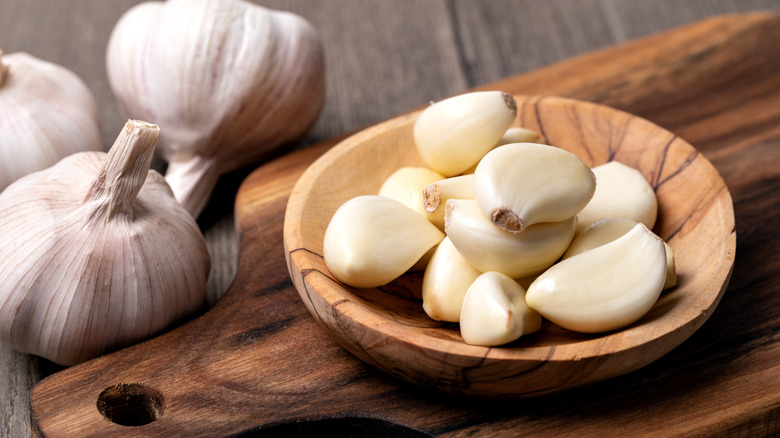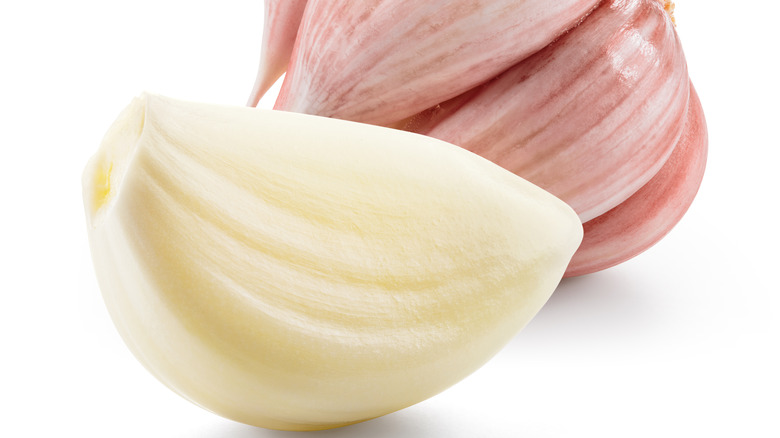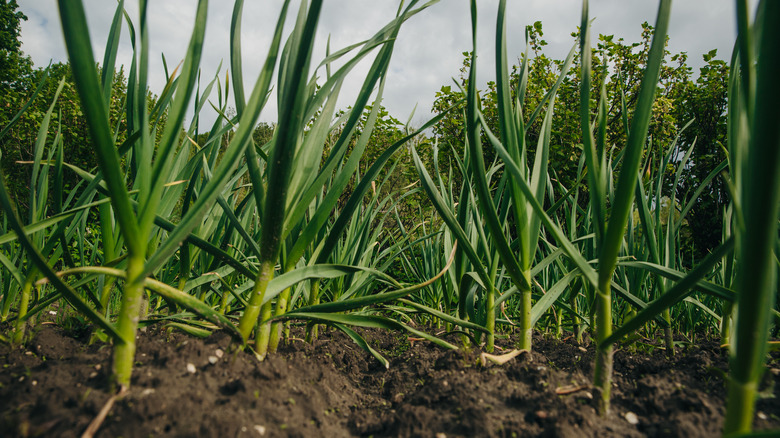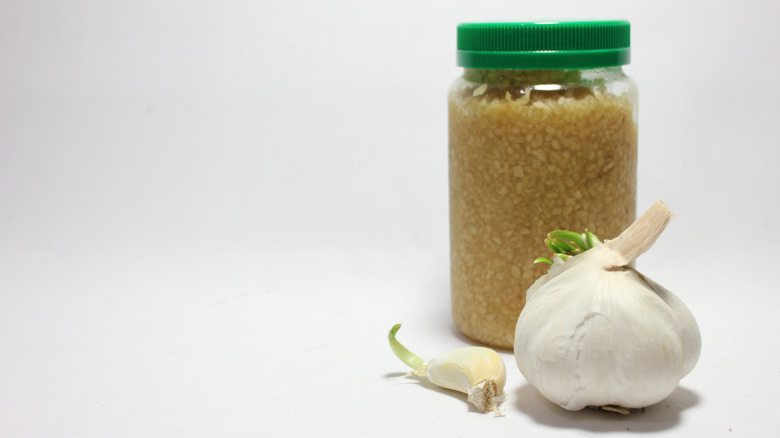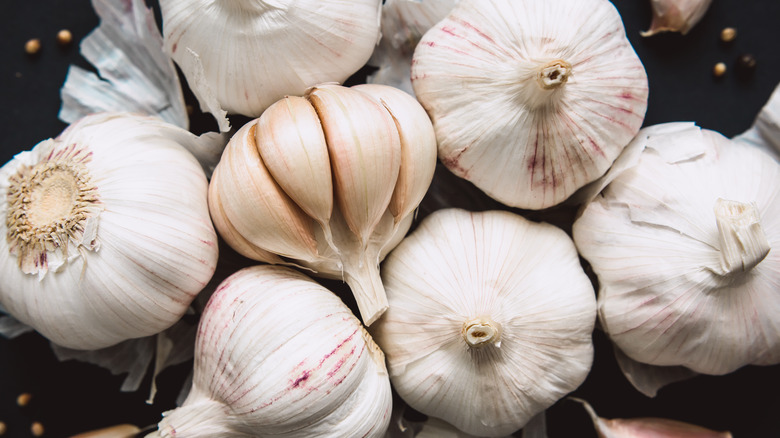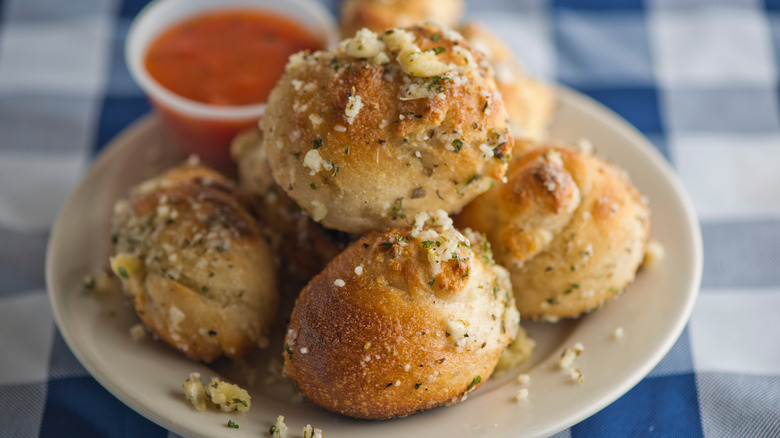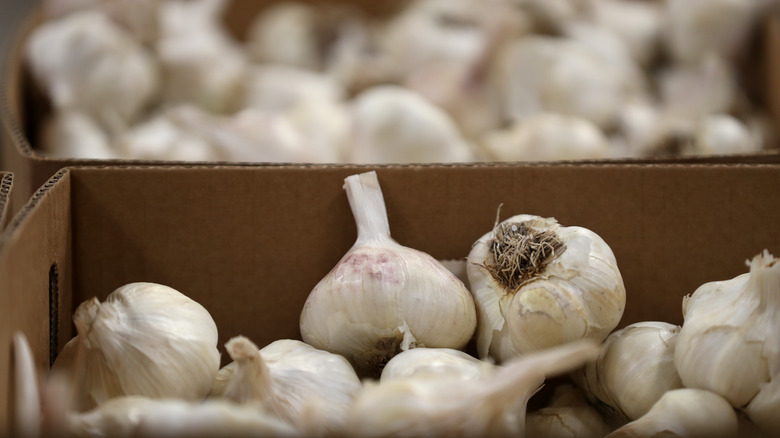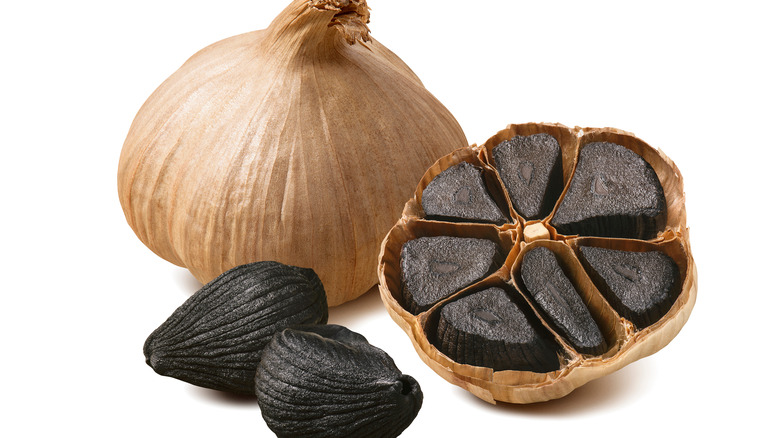What Is A Garlic Clove Really And How Do You Use It?
Ah, garlic. The six-letter word for love. A beautiful white bundle of flavor and fragrance just waiting to supercharge your next dish. Garlic (Allium sativum) is one of those staple ingredients that can be found in almost any kitchen — good luck, vampires! But many of us use who use garlic regularly still don't know where it comes from or what other magic it holds besides its taste and smell.
Specifically, we're talking about the small, crescent-shaped cloves that make up a head of garlic. You know, where all the action happens. Garlic cloves are extremely useful and versatile in cooking, and there are a multitude of ways to cut and incorporate them into dishes. They also offer some interesting health benefits, too. Let this be your deep dive into what exactly a garlic clove really is and how you can make the most of it the next time you check it off your grocery list.
What is a garlic clove?
Let's back things up just a bit so we can cover the garlicky basics. For those of you who don't already know, the full, white, bulb-shaped thing you buy at the store is what's known as the garlic head. It's round and firm with a teardrop-shaped base and a short, flakey stalk on top.
Beneath its papery white skin, the garlic head comprises several cloves, which are all individually wrapped in their own papery skin and connected at the root of the plant (yes, garlic grows as a plant). A head of garlic can range in size depending on where and how it is grown, but can be anywhere from the size of a lime to the size of a large tomato. Cloves themselves also vary in size — even within the garlic head itself — and can be as big as a peanut in its shell or as small and thin as sunflower seeds.
Where is garlic found?
Garlic, or Allium sativum, is a perennial plant that's native to Asia but also grows in Italy and France (via Britannica). The white bulb of garlic grows beneath the soil, sprouting long, bright-green stems. Garlic plants have an appearance similar to leeks, shallots, and onions, its relatives in the lily family. Britannica notes that long ago, garlic was "prized" for having health benefits and "was carried as a charm against vampires and other evils."
Garlic is a very common cooking ingredient and is often a kitchen staple. For that reason, it is easily found in most grocery stores and farmers markets. However, the garlic that we know — a head made up of cloves — is different from what is known as wild garlic, or Allium ursinum. This type of garlic has a similar flavor to garlic cloves, but is more mild. Wild garlic is related to chives and grows near water sources primarily in Britain and across Europe, The Spruce Eats notes.
Raw vs. processed garlic
If you're shopping at a grocery store for garlic, you might also notice there are varieties of packaged garlic in jars or other containers. This type of garlic is typically finely chopped or minced and in its own garlic juices. Because this kind of garlic is mass-produced and stored post-chop, the flavor is more mild and less fresh-tasting than if you purchase a head of garlic with its protective papery skin.
There can be a huge difference both in flavor and smell between a fresh clove of garlic and pre-chopped jarred garlic — the late Anthony Bourdain was notably not a fan of the latter. If you purchase a head of garlic and use its cloves on an as-needed basis, you can choose how you'd like to cut, prepare, and cook each clove depending on what you're looking for in flavor, intensity, and texture. With pre-packaged garlic, you are limited to the way that garlic is already cut and the less intense flavor it likely has.
What does garlic taste like?
Garlic has a very unique flavor profile, which is what makes it such a desirable ingredient in so many types of dishes. Its flavor can be very strong or relatively mild depending on if it is raw or cooked. According to The Spruce Eats, raw garlic has a pretty pungent flavor, which can be likened to somewhat bitter and grassy, with a crunchy texture. Garlic is not commonly eaten raw. The more finely cut and more thoroughly cooked the garlic, the milder its flavor and softer its texture — though be careful, as finely chopped garlic can be easier to burn.
Roasting garlic cloves in particular changes their flavor profile quite a bit, yielding a creamy, paste-like texture with a mild, nutty flavor. Other methods of cooking garlic, like in a sauté, offer a milder flavor but one that is more closely related to garlic's natural, raw flavor profile. Using garlic in a recipe is a great way to add a slightly earthy, grassy, nutty flavor to any dish.
How to cook with garlic cloves
Garlic is one of those universal ingredients often used in savory dishes or as a base for making sauces, sautéeing vegetables, or cooking meats. While you can eat garlic raw, you probably won't want to: Garlic is best enjoyed when cooked to some degree, where its flavor becomes milder. One of the easiest ways to use garlic is as a sauté base or in a sauce. Just be careful when adding garlic to your pot or pan. Using too high a temperature will burn the garlic quickly and ruin the flavor.
There are several ways to cut garlic cloves, which will affect the intensity of its flavor, MyRecipes explains. You can roast a whole head of garlic in order to get the cloves soft and pastelike, or throw entire cloves into a dish. Popular ways to incorporate garlic cloves include cutting them in some way, whether finely chopped, thinly sliced, or minced in a garlic press. The more surface area exposed when prepping garlic cloves, the faster they will incorporate into your dish and the milder the flavor will be. Roughly chopped bits of garlic will take longer to cook and can add some texture and crunch, but they'll also have a stronger flavor. Minced garlic will produce the most subtle garlic flavor (a "classic garlic profile," as MyRecipes puts it) but will have the least amount of added texture.
Where to buy garlic
Despite coming from a plant, garlic is a dry ingredient, meaning you won't find it among the vivid vegetables in the produce section that are kept cool and regularly misted. You'll find garlic close by its relatives (onions) and other pantry-safe vegetables like potatoes. Depending on your store's selection, you may have a variety of individual garlic heads to choose from, priced per pound, or bags with several heads inside at a set price. There are also a few different varieties of garlic to choose from, but softneck garlic is primarily what you'll find in most grocery stores.
According to Cook's Illustrated, shopping for garlic by individual heads is the best method, since you can examine each garlic head thoroughly for any impurities. When choosing your garlic, avoid any with brown spots, mold, or sprouts growing — these are definite signs that a head of garlic is past its prime. Give the garlic head a good squeeze to check its firmness, too; you don't want garlic that feels squishy or rubbery, or even one that smells tangibly like garlic. You only want that sweet garlic fragrance when your cloves are peeled, cut, or actively cooking!
Other varieties of garlic
As mentioned, the most common type of garlic is Allium sativum, but other varieties (like the aforementioned wild garlic) also exist. Garlic as we know it is often categorized into four varieties: hardneck, softneck, black, and elephant garlic. Softneck garlic is what you most often see in grocery stores and what is commonly used in most recipes. This type of garlic is the most coveted because it has large cloves and stores well, so it is available year-round (via Cook's Illustrated).
Hardneck garlic also has relatively large cloves and is thought to have a more complex flavor than softneck garlic. Hardneck garlic is distinguished by its smaller, bulbous bottom and long, straight stem, and is typically only available at farmers markets in July and August. Elephant garlic is not actually garlic; it's much more similar to leeks. While it bears the name garlic, elephant garlic's flavor profile is much different.
Finally, there is black garlic, which is the result of a fermentation and air-drying process that yields dark, purple-colored cloves. It has a "sticky, chewy texture and ... flavor reminiscent of molasses or reduced balsamic vinegar," according to Cook's Illustrated. Black garlic is best when chopped or sliced rather than minced or added to a larger dish, where its signature flavor will get lost.
